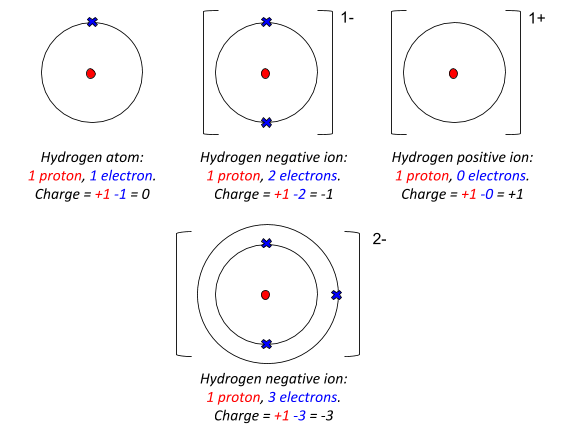Ionic Bonding
Ions
What you need to know:
What an ion is and why they have a charge.
An ion is basically just a charged particle! They can be positive or negative, depending on whether they have more protons than electrons or more electrons than protons.
Notice that in the picture above, the ions have square brackets around them with the charge in the top right hand corner! It is very important that you remember to do this every time you draw one! It’s also important to put the number before the sign (i.e 2-).
A few things to remember:
- Ions are charged particles
- Ions can be positive or negative
- You can find the charge of an ion by counting how many electrons and protons it has
- Like charges repel, opposite charges attract
Bonding
What you need to know:
Why atoms react with each other by sharing/giving electrons.
Atoms are not happy unless they have a full outer shell of electrons. Atoms deal with this by either sharing or taking/giving electrons __with other atoms to acquire a __full outer shell of electrons.
There are 3 types of bonding:
- Ionic bonding - when metals and nonmetals give/take electrons from each other
- Covalent bonding - when nonmetals share electrons with other non-metals
- Metallic bonding - when metals form a lattice of positive ions surrounded by a sea of electrons.
The more electrons that are shared/taken/lost, the stronger the bond.
Ionic Bonding
What you need to know:
What is ionic bonding.
What type of elements bond via ionic bonding.
Ionic bonding is the type of bond that forms between metals and non-metals. Ionic bonding is when a non-metal takes electrons from a metal. This means that the non-metal becomes negatively charged (since it has more electrons than usual) and the __metal becomes positively charged __(since the metal has less electrons than usual).
The two ions are then very strongly attracted to each other, since they have opposite charges. This attraction is called an electrostatic force of attraction. When this attraction comes around via two particles exchanging electrons, it’s called ionic bonding.
A few things to remember:
- Ionic bonding happens between metals and nonmetals
- Metals become positively charged
- Non-metals become negatively charged
- The two are then very strongly attracted to each other since they are oppositely charged
Ionic Compounds
What you need to know:
How to draw a dot cross diagram for ionically bonded substances.
How to use curly arrows to show the movement of electrons.
You can often tell which atoms usually form bonds with certain atoms, depending on how many electrons are in the outer shell. For example, group 1 atoms easily form ionic bonds with group 7 atoms. Since one atom needs to lose 1 electron and the other needs to gain 1 electron (this is NOT the only time ionic bonding happens).
Representing ionic bonding:
Ionic bonding is represented using dot and cross diagrams. These are called dot and cross diagrams since dots and crosses are used to represent the electrons in different atoms (so that it can be easily seen where the electrons came from). The most important thing with ionic bonding equations, are curly arrows, electrons and square brackets! Here is an example of ionic bonding happening between a group 1 and a group 7 atom.
A hydrogen atom is giving an electron to a fluorine atom. After this has happened, the hydrogen is now a positive ion which is attracted to the now negatively charged fluorine ion! This attraction forms an ionic-bond.
How to write an ionic equation step by step:
- Double check that you have (at least) one metal atom and one nonmetal atom.
- Draw one of the atoms, including all of the electrons (you can just put the nuclear symbol where the nucleus should be).
- Draw the second atom to the right of this one (leaving a little bit of space).
- Draw a + sign between the two
- Draw a curly arrow (make sure it’s curly) going from the metal atoms spare-electron(s) to the space it will occupy in the nonmetals outer shell.
- Draw a straight arrow after the second atom (like you do in a normal equation).
- Draw the two ions that have formed, with the electron(s) that has moved. Draw them next to each other, remembering to include the square brackets and charge number!
More dot and cross diagrams:
A Lithium atom is giving an electron to a fluorine atom. After this has happened, the Lithium is now a positive ion which is attracted to the now negatively charged fluorine ion! This attraction forms an ionic-bond.
A Magnesium atom is giving 2 electrons to an Oxygen atom. After this has happened, the Magnesium is now a positive 2+ ion which is attracted to the now negatively charged 2- Oxygen ion! This attraction forms an ionic-bond.




